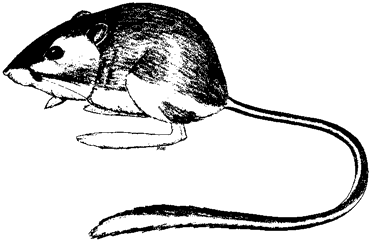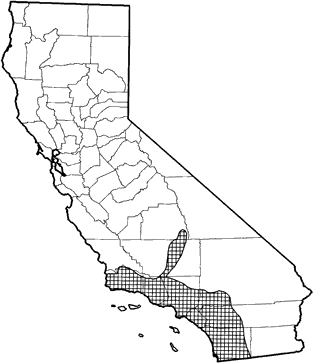
Pacific Kangaroo Rat
Distribution, Abundance, and Seasonality
Common, year long resident of southern California. Inhabits South Coast region, generally west of the Mojave and Colorado deserts, from the Mexican border north to the Santa Barbara-San Luis Obispo Co. Iine. Also occurs in Tehachapi and Piute Mts. inland to South Fork of Kern River in southeastern Tulare Co. Found in coastal scrub, open stages of chaparral, and desert scrub habitats, and in some conifer woodlands. It occurs in habitats below 2250 m (7400 ft).

Range Map
Specific Habitat Requirements
Feeding: Primary foods include seeds of grasses, forbs, and shrubs (Meserve1976a). Forages on open ground adjacent to shrubs, searching for, andgathering, food. Large amounts of food can be held in cheek pouches, some of which later isstored inunderground caches.
Cover: Burrows are excavated in friable soils. Shrubs and herbageprovide coverduring above-ground activities.
Reproduction: Nests in burrows excavated in friable soils.
Water: Probably needs drinking water (MacMillen 1964).
Pattern: Open areas with scattered vegetation and friable soilsprovide suitablehabitat for D. agilis.
Species Life History
Activity Patterns: Yearlong nocturnal activity.
Seasonal Movements/Migration: Non-migratory.
Home Range: Home ranges varied from 0.1 to 0.6 ha (0.4 to 1.5 ac), with a mean of 0.3 ha (0.8 ac) (MacMillen 1964).
Territory: Females may be territorial during breeding season. Territory and homerange probably are the same size.
Reproduction: Reproduction occurs from January into July. Litter sizeranges from 2-4; average =2.6.
Niche: D. agilis is closely related to D. heermanni and D. venustus. Unlike most other Dipodomys, D. agilis is not well adapted to extreme xeric conditions. Rattlesnakes, owls,badgers, foxes, skunks, weasels, and coyotes are likely predators. Other seed-eating species may compete when food is scarce.
Sources & References
California Department of Fish and Game, 1999.
California's Wildlife, Sacramento, CA.
Written by: G. Ahlborn, reviewed by: M. White, edited by: M. White
Bleich, V. C. 1973. Ecology of rodents at the United States Naval WeaponStation, Seal Beach, Fallbrook Annex, San Diego County, California. M.A. Thesis,California State Univ., Long Beach. 102pp.Bontrager, D. R. 1973. Rodent ecology of the Santa Rosa Plateau, RiversideCounty, California. M.A. Thesis, Calif. State Univ., Long Beach. 115pp.Christopher, E. A. 1973. Sympatric relationships of the kangaroo rats,Dipodomysmerriami and Dipodomys agilis. J. Mammal. 54:317-326.Grinnell, J. 1922. A geographical study of the kangaroo rats ofCalifornia. Univ. Calif. Publ. Zool. 24:1-124. MacMillen, R. E. 1964. Population ecology, water relations and social behavior of a southern California semidesert rodent fauna. Univ. Calif. Publ. Zool.71:1-59.Meserve, P. L. 1976a. Habitat and resource utilization by rodents of aCalifornia coastal sage scrub community. J. Anim. Ecol. 45:647-666.
Meserve, P. L. 1976b. Food relationships of a rodent fauna in a Californiacoastal sage scrub community. J. Mammal. 57:300-319.
Stock, A. D. 1974. Chromosome evolution in the genus Dipodomys and itstaxonomicand phylogenetic implications. J. Mammal. 55:505-527.
California Animal Facts | California's Wildlife